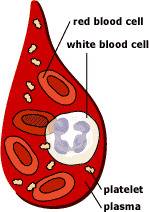
BLOOD AND ITS ELEMENTS
Study the new words.
1. fluid connective tissue – жидкая соединительная ткань
2. cellular elements – клеточные элементы
3. platelets – пластинки
4. nucleus – ядро
5. lobe – доля
6. life span – продолжительность жизни
7. pierce the skin – прокалывать кожу
8. wound – рана
9. engulf the bacteria – поглощать бактерии
10. features – свойства
11. flexibility – гибкость
12. substance – вещество
Read the text. Pay attention to the new words for better understanding.

Blood is a fluid connective tissue with many various functions. Many important physiological process take place in the blood. It also determines the activity of separated body cells.
Blood is composed of plasma and the cellular elements. They are red blood cells (erythrocytes), white blood cells (leukocytes) and blood platelets (thrombocytes).
About 65 per cent of all white cells are leukocytes. Their protoplasm contains granules. One characteristic of leukocytes is the lobed appearance of the nucleus. The number of lobes is thought to be an index to the cell’s age. About 45 per cent of all leukocytes have a nucleus of three lobes. The life span of a leucocyte is short, from 4 to 12 days.
The function of leukocytes is to protect against infection. After the skin is pierced and the wound becomes infected, leukocytes from all the body are attracted to this place. Arriving at the wound, they leave the blood stream. They engulf the bacteria within their own protoplasm. This process is called phagocytosis.
Erythrocytes are the most numerous cellular elements. Red corpuscles have two physical features which are very important in the function of respiration. They have great elasticity and flexibility. These features give them the possibility to pass through very small capillaries. The most important part of the red cell is its red substance or hemoglobin.
The average human blood volume is not less than 7.5% but not more than 10% of the body weight.
Fill in the table using the information below
|
Corpuscular elements |
Features |
|
Leukocytes |
1. 2. … |
|
Erythrocytes |
1. 2. … |
White corpuscles; numerous cellular elements; have elasticity and flexibility; have granules in the protoplasm; pass through small capillaries; have a short span of life; have a lobed appearance of the nucleus; take part in the function of respiration; contain red colouring substance ( hemoglobin ); protect against infection; arrive at the wound and engulf the bacteria.
Answer the questions to the text “Blood and its elements”. Translate the answers.
1.What kind of tissue is the blood?
2.What is the blood compose of ?
3.What is the charachteristic of leukocytes?
4.What is the function of leukocytes?
5.What do leukocytes do when a wound becomes infected?
6.What are the most numerous cellular elements?
7.What features do erythrocytes have?
8.What is the important part of erythrocytes?
9.What is the total blood volume divided into?
Translate into English using the text “Blood and its elements”.
1. Кровь – это жидкая соединительная ткань.
2. Кровь состоит из плазмы, красных кровеносных телец, белых кровеносных телец и тромбоцитов.
3. Лейкоциты содержат гранулы.
4. У лейкоцитов есть ядро с тремя долями.
5. Функция лейкоцитов – защищать от инфекции.
6. Эритроциты – это многочисленные клеточные элементы.
7. Их физические свойства – эластичность и гибкость.
8. Эритроциты играют важную роль в функции дыхания.
9. Эритроциты содержат вещество гемоглобин.
Continue the sentences using the text “Blood and its elements”. Translate the sentences.
1. Blood is …
2. Blood is composed of …
3. Thrombocytes are …
4. The protoplasm of leukocytes …
5. Leucocytes have …
6. The function of leukocytes is …
7. Erythrocytes are …
8. Erythrocytes have …
9. The important part of erythrocytes is …
10. Erythrocytes play an important role in …
Match the parts of the sentences using the text “Blood and its elements”. Translate the sentences.
|
1. Blood is a fluid … 2. Blood determines … 3. The corpuscular elements are … 4. The protoplasm of leukocytes contain … 5. The nucleus of leukocytes has … 6. Leukocytes … 7. Erythrocytes are … 8. The features of erythrocytes are … 9. Erythrocytes contain … 10. Red corpuscles take part in … |
- granules. - protect against infections. - connective tissue. - red substance hemoglobin. - erythrocytes, leukocytes and thrombocytes. - respiration. - three lobes. - elasticity and flexibility. - the activity of the body cells. - red corpuscles. |
Match the idiomatic expressions with their definitions. Learn them
|
1.blood is thicker than water 2.to chill the blood 3.blue blood 4.flesh and blood 5.you can’t get blood out of a stone 6.it runs in the blood |
a. the sign of aristocracy b. human with all the weakness of human nature c. to get very scared d. the ties between relations are closer than those between friends e. to have inherited traits f. a passionless man
|
Answer the questions
1.Have you ever got situations which chill your blood?
2.Do you have examples when you can’t blood out of a stone?
Speak about blood.
Материалы на данной страницы взяты из открытых источников либо размещены пользователем в соответствии с договором-офертой сайта. Вы можете сообщить о нарушении.